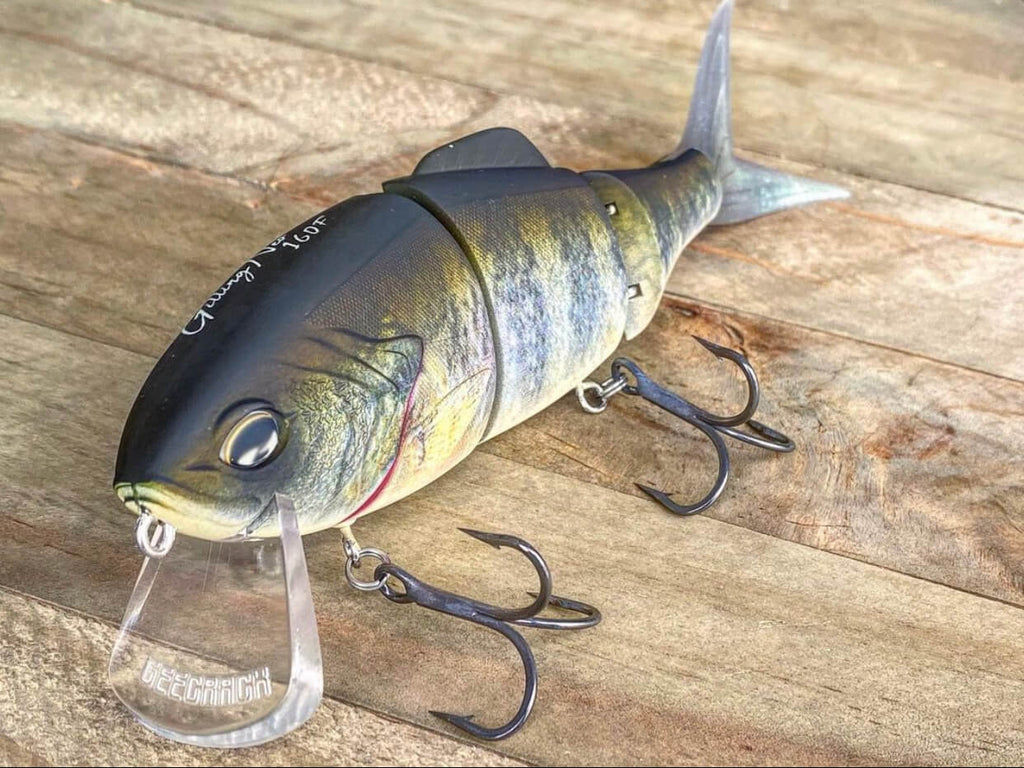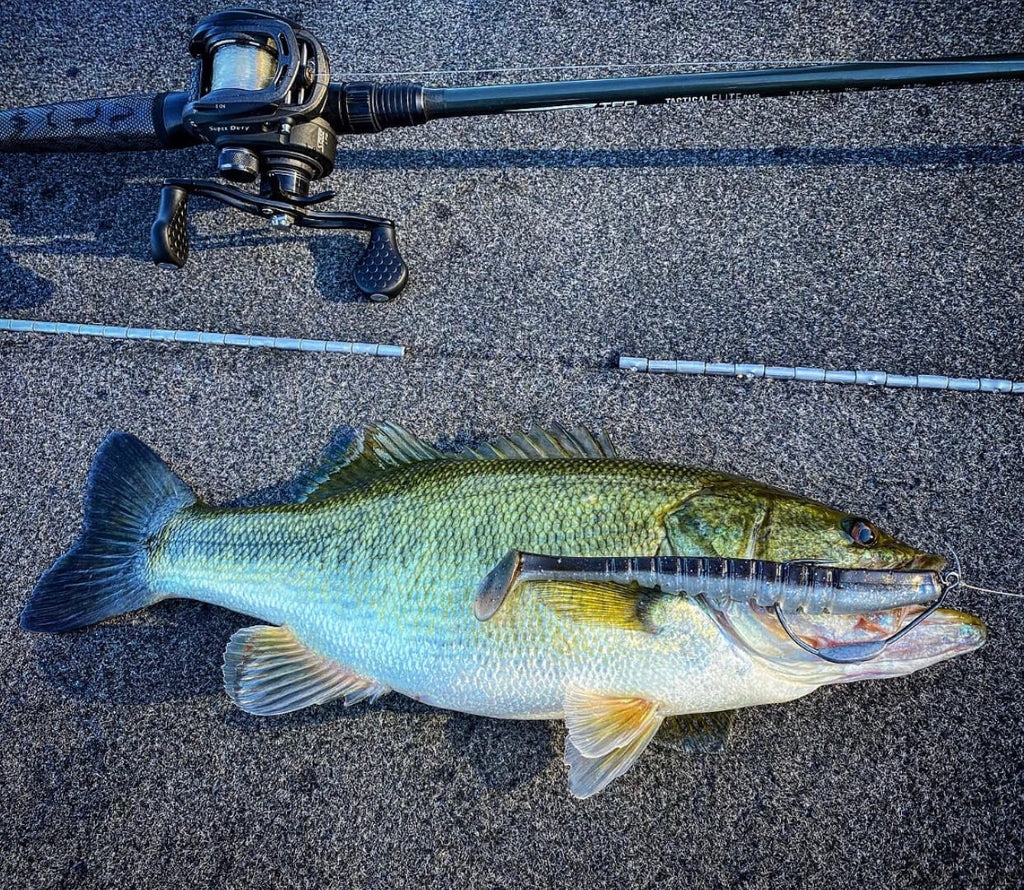Bass fishing is a beautiful challenge. And unless you’re the next KVD (the real one), those bigguns are probably going to be able to avoid your typical bait. Large bass are smart, small bass are quick, and midsize bass got the best of both worlds. So, you'll need to have patience if you want to bag a fresh catch.
Swimbaits are great for bass fishing because of their realistic appearance, and when rigged properly, they can easily mimic the look of its prey. So, you’ll need to take some care to properly rig the bait before hitting the water.
Let’s take a look at some easy and helpful tips for how to make the most of your swimbaits.
Think About Your Style
There are so many different types of swimbaits. This can make it difficult to know exactly which one is right to throw at your favorite spot. Even the best of us have burned through time and money on a bait that quite didn’t mesh with the terrain. Don’t worry. We can fix that.
Hard Body Swimbaits

Hard body swimbaits have a hard body (shocking, right?). This means that manufacturers spend a lot of time fine-tuning details on their bodies, making them look very realistic compared to other swimbaits.
And a realistic bait is an effective bait—especially in waterways with no weed covering. Hard body baits can even be multi-jointed, and some of these basically look more like real fish than actual fish.
The only problem is that, while all swimbaits tend to be pricey, the level of intricacy of hard bodied baits makes them even more expensive. So while they’re great choices for experienced veterans who make a living reeling ‘em in, they aren’t always worth it for amateur trollers.
Not to mention, hard swimbaits will get stuck in thick weed cover if you’re not careful. Even models that say they’re weedless can’t really maneuver through that thick grass. So, hard bodied baits are really great choices, but only in clear water and when controlled by a seasoned angler.
Soft-Bodied Swimbaits

Also unsurprisingly, soft bodied swimbaits are baits that have soft bodies—surprise! They’re made of rubber or plastic, and the high quality ones can take some serious wear and tear, so you can use them on multiple excursions. They feel pretty realistic, too, so they can be a great bet to nab a bass.

Pro Tip: If you’re a bit newer to bass fishing, these may be the swimbaits for you. Their low price makes them good picks for most anglers, but especially newbies. You’ll need to be careful, though, because full body models don’t always come with hooks attached, so you’ll have to attach your own eyelet to the hook rings.

Regardless, it’s tough to go wrong with any type of swimbait. They should be a staple in any well-stocked tackle box, and they make great gifts for the avid anglers in your life.
So, How Do I Rig One?
There are a ton of different ways to rig a paddle tail swimbait. You could throw them on a buzzbait, chatterbait, a spinnerbait -- pretty much anything your heart desires. Three methods stand out, though, as easy, effective, and worth learning about.
On a Swim Jig
Paddle tail baits are great to attach to the back of a swim jig because they can draw bites from the big ones. They have a wide, thick profile that’s bigger than a typical paddle tail bait. Plus, it gives the impression of a realistic, swimming baitfish to help you nab an unsuspecting bass.
Most swim jigs are weedless, so they’re versatile and can be used pretty much anywhere. But the weed guard on top pops down super easily, so it can quickly catch a bite without getting caught in the surrounding areas.
On and Underspin

You can easily attach swimbaits on an underspin to give some added action to your reel. Since they pair with pretty much any swimbait, you can mix and match pairs till the rivers run dry.
We recommend pairing an underspin jig with a swimbait with a pair of eyes—you’ll be able to fool a bass into thinking it’s a tasty snack. The willow blade of the underspin will flicker underneath the larger paddle tail target on top, which means double the targets, double the prospective catches.
On a Belly-Weighted Hook

This is a more traditional method for rigging a swimbait, but it’s tradition for a reason! A belly-weighted hook gives you the freedom to adjust to your terrain and any issues that may come up.
Most larger hooks stick out of the top of the bait, but modifying the body to conceal it for weedless fishing is a snap. Even if the hook’s a little exposed, you shouldn’t run into any issues.
Pro Tip: This method works best with soft-bodied swimbaits, so plan ahead before you cast off.
Casting and Retrieving

Swimbaits are pretty similar to most crankbaits, with a few major differences. With both, you’ll have to use some sporadic action to break up the repetitive motion of the reel. Remember, those bass are smarties, and some of ‘em have figured out how to spot bait. You’ll have to bank on patience, luck, and a bit of creativity to nab a big catch.
Floating models of swimbaits are often used as topwater lure and work best fluttering just underneath the surface, because it imitates a dying bait fish. These are easy prey for bass, so it’s likely that they’ll jump at the chance to snag a snack. This technique works best in the morning, evening, or when the water is calm, so you don’t risk too much movement looking suspicious.
When it comes to deep water columns or areas chock full of grass, swimbaits that sink and dive should be your go-to. These will bob up and down, looking like a living bait fish to lure in your prey. Sink and dive baits can even be dragged along the bottom of the lake’s surface, so if you’ve got a boat, give this style a try.
Remember that you can’t give the bass time to investigate the lure before they bite, or they might suspect something is up. Concealing the bait in deep, dark water or in patches of thick weeds works in your favor so that the fish doesn’t see any unnatural qualities. But don’t worry too much about finding the perfect spot. If you toss the bait into any areas with a ton of grass cover, you should be A-okay.
Make sure you have different tools and options at the ready when you’re garring out, because you never know exactly what’s gonna happen during a day on the lake. Keep a bunch of fresh, diverse baits ready at any given moment so you can be ready to nab a fatty.
Your rod can also be a game changer because you need a sturdy one if you’re going to try to catch a stud. Manufacturers have designs specifically for catching a really big lunker. These rods are powerful, sturdy, and long, and if breaking some world records with your next big catch is your goal, invest in some solid tools.
Now for the reel, you need to go 7.5 or faster. These are moving baits, so you want to keep it moving at all times. And then, when a fish bites, you want to be able to pick it up fast.
Swimbait hooks tend to be pretty heavy gauge. You’ll want to use a line that is between 17 and 20 fluorocarbon. This seems hefty, but bass can be monsters and there’s no greater tragedy than your line snapping as your reel in your next catch.
Retrieval is pretty straightforward. Cast these baits like normally do, and once it hits the water, count about a second per foot that you want the bait to drop. That means if you want to fish a steady retrieve right underneath the water column, just count about a second or two.
When you finally nab a bite, you really need to lay into these guys. These are heavy hooks, with a heavy line, on a heavy rod, attached to an even heavier fish. But, it’s a steady retrieve. You’ll just need to be ready at a moment’s notice to set the hook.
Conclusion
Whether you’re new to fishing or you’ve been hitting the community holes since you were born, the right way to rig a swimbait can change the way you play the game. Having different options ready to go can help you win the fins, even when different scenarios come up.
But no matter what, if you’ve got yourself a heavy-duty rod and line, you shouldn’t have any problem looking like a pro.
Sources:
https://fishingbooker.com/blog/fishing-hooks-101-parts-sizes-types/
https://blog.mudhole.com/3-types-crankbaits-catch-fish/#.X-C7hmRKg-Q
← Older Post Newer Post →


